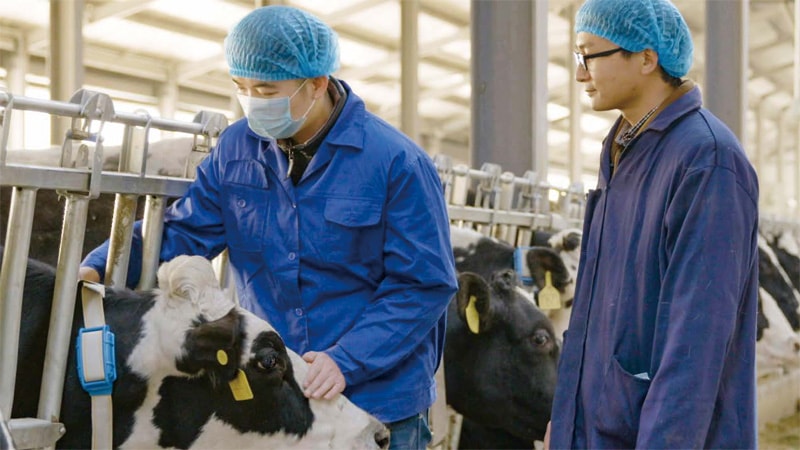A New Cash Cow in the Dairy Field
For telcos, there are several IoT business models to choose from. Find out how China Telecom has picked the most profitable in the area of dairy farming with its product UCOWS.


By Zhanghai, Chen Hua & Liu Jianfeng
China's dairy farming industry is starting to adopt large-scale, intensive, tech-based production methods resulting in many opportunities that are too good to miss. In the case of connected cows, strong partnerships have created success based on NB-IoT technologies.
China's dairy industry today
China's dairy farming industry is marked by two characteristics: a significant lack of technological capabilities and huge growth potential.

Livestock numbers: After over ten years of expansion, growth has leveled out. In 2015, there were almost 15 million dairy cattle in China, putting the nation behind India, the EU, and Brazil in numbers. The industry’s CAGR since 2012 has been 0.5 percent.
Per capita consumption of dairy products: In 2016, China's per capita consumption of fresh milk was equivalent of 36.1 liters, about one-third of the world average. This figure belies the nation’s robust economic growth, clearly indicating huge room for growth in dairy consumption.
Average per-cow yield and dairy herd size: Annual per-cow yield in China is about 6 tons, which places China somewhere in the middle of the rankings table. By contrast, India, where free-range, extensive farming is prevalent, has one of the world's lowest annual per-cow yields at just 1.22 tons. In the US, Japan, and South Korea – countries that use factory farming techniques – per-cow yield exceeds 9 tons. In China, the percentage of dairy farms with more than 100 cows is 48 percent, whereas in the US it tops 80 percent.
Monitoring what’s vital
Widely raised in China, Holstein cows enter physical and sexual maturity at 14 months. After a 280-day gestation period, the cows produce milk for 300 days. Cows can be bred again 55 days after calving, falling to 50 days after the second calf. On average, cows enter a two-day estrus period every 21 days, during which time they can be bred.
As physiological cycles vary for individual cows, successful breeding and maximum profitability requires that dairy farms can identify the estrus period correctly. Missing a cow's estrus period can result in an about 2,000-yuan loss – assuming a milk yield of 30 kg per day and a value of 3.6 yuan (US$0.7) per kg of milk.
Currently, most dairy farms employ vets to monitor cows' estrus cycles using manual methods such as rectal examinations, behavioral observation, and tail base painting. However, it’s easy to miss when a cow is in estrus. About 65 percent go into heat between 9 pm and 4 am, and individual cows behave differently when in estrus. High-yield cows have a shorter estrus period, and there's no set best breeding time after a cow goes into heat. Rates of successful detection using manual checks therefore sit at less than 75 percent. Furthermore, this method is very labor-intensive with high manpower costs, as it requires vets to carry out inspections in shifts.
Some dairy farms opt for estrus synchronization for cows that haven’t been bred during their estrus period. This involves injecting them with hormones and breeding them all at the same time when they go into heat three days later. However, the breeding success rate of hormones is 9 percent lower than natural estrus. They also interfere with a cow's estrus cycle, resulting in lower quality milk and health problems for the animal. Repeated injections also compromise a cow's immunity to disease and shorten life expectancy.
To improve the efficiency of large-scale farming, dairy farms are applying tech like smart cow collars to monitor vital signs in real time. Data from cow collars is collected by small cells (readers) and uploaded to a data management platform via 3G or 4G, with data transmission achieved through short-range communication methods such as ZigBee. The cow data management platform carries out big data modeling on each cow's vital signs, producing a full health report that includes diagnosing illness and estrus cycle data. Farmers can then use this data to feed the animals more scientifically and carry out treatment and breeding at the right times.
Smart collar solutions produce higher estrus detection and fertilization rates than manual inspection methods. This can lower breeding costs and avoid the use of health-damaging hormones. However, this type of solution isn’t problem-free.
Complex installation: Small cells are installed on-site and data backhaul is completed on the telecom operator's network, both of which require technical expertise to set up.
High fault rate: System reliability is low because of the tough farm environment, poor power supply conditions, and account arrears.
High costs: It’s not viable to apply universally on small and mid-sized dairy farms and can represent a financial burden even for large farms.
Leading the herd with UCOWS

In February 2017, China Telecom partnered with Huawei and Yinchuan AOTOSO to create a new solution and business model targeting the livestock sector, resulting in the NB-IoT product, UCOWS, which is a vast improvement over traditional cow monitoring systems.
The tech
UCOWS harnesses NB-IoT instead of ZigBee for smart collar communications. Collar data is transmitted via China Telecom's NB-IoT network directly to its open IoT platform and transferred to a cow data management platform deployed on China Telecom's eCloud. Dairy farm managers, farmers, and vets have real-time access to cows’ vital signs on a mobile app or website.
As the product is one of China Telecom's own, the operator is responsible for sales and services and also E2E reliability, which is crucial for large-scale commercial adoption.

Power consumption: Because collars are worn for the cow's entire lifetime, they're fitted with low-power MCUs and sensors that give at least five years of battery life. The devices are also rated IP65 to meet the needs of the harsh dairy farm environment. The data for cows’ vital signs must be reported once every three hours, much higher than smart meters' once-per-day reporting. Since adding batteries would increase the cost and weight of the collars, power consumption requirements for the collars were therefore extremely high.
The solution design uses conventional NB-IoT battery-saving features such as PSM, with CDRX and RA features applied to chips, base stations, and the core network. CDRX boosts collar battery life from five to six years, and RA extends it to seven years.
Congestion: Large dairy farms can easily contain 10,000 to 20,000 cows. With each IoT cow collar reporting eight times a day, multi-device access is a very common scenario. Lab testing shows that when multiple devices report data simultaneously, base station noise is raised, making them inaccessible.
Therefore, backoff and preamble parameters were included in the solution design to increase system robustness. Devices access the network and upload data in a staggered manner, better suiting NB-IoT networks.
UCOWS is connected to China Telecom's Open IoT platform, which supports chip firmware upgrades and device MCU software upgrades, E2E fast fault demarcation, and million-level concurrent connections – all of which are conducive to large-scale adoption of the solution.
Business design
If operators want to increase profits in the IoT sector, they have to offer more than just connectivity. They also need to provide connection management platforms (CMP) and application enablement platforms (AEP) and enterprise solutions, including upper-layer applications and devices, from partners. Then, they can offer end-to-end solutions to enterprise customers, extrac additional value on top of connections, and boost customer loyalty.
Partners can collaborate with operators by using their AEPs to develop industry applications and harnessing national networks to quickly attract users and a share of the profits. Enterprise customers can in turn benefit from the increased efficiency IoT brings without needing any IT capabilities.

The business model of the UCOWS solution was designed based on the SaaS model, which lets China Telecom leverage its NB-IoT networks, sales channels, and customer service capabilities to the fullest extent. The operator has been able to bypass the pipes and platforms stage and move straight to selling services, shifting from an industry bystander to an industry leader that can pull in four to five times more revenue than is yielded by the dumb pipe model.
This model also lets the telco also build its own ecosystem, providing a foundation for future applications such as food traceability.
Market outlook
Thanks to its excellent technological solution and business model design, UCOWS has met with strong market demand. In August 2017, China Telecom's Ningxia subsidiary signed a contract with Ningxia Shangling Animal Husbandry for 50,000 sets. Then in September, China Telecom's deputy general manager signed contracts with animal husbandry companies from five provinces and autonomous regions − Inner Mongolia, Shandong, Shaanxi, Liaoning and Ningxia − for China Telecom to supply a total of 1.26 million product units. It’s also caught the attention of operators in the Asia Pacific and Latin America regions, where China Telecom is already carrying out pilots.
The solution isn’t limited to cows – it can be applied to cattle, donkeys, horses, sheep, and pigs, all of which have a demand for technology to monitor animal health, physiology cycles, location, and other types of data, so as to shorten time between breeding and increase breeding efficiency. According to conservative estimates, demand will be there for 300 to 500 million connected animals by 2020. Optimistic predictions put this figure in excess of 1 billion.
By applying ICT technologies such as NB-IoT to connect animals, the livestock industry will be able to completely transform and approach breeding in a much more scientific way. IoT will increase industry profits, reduce drug use, increase the well-being of animals, and increase the quality of livestock products.




